Pump for cleaning wells: selection criteria and operating rules
Previously, work on cleaning the well bottom was carried out exclusively by hand using buckets and ropes.Now pumping equipment helps to cope with this problem. Using technology, the cleaning procedure is much simpler and much faster. Do you agree?
We will tell you how to choose the ideal pump for cleaning wells, capable of pumping water containing sand and fine gravel. Here you will find out whether the borehole or drainage model will better rid the mine of silt and mineral deposits. You can choose the most efficient equipment.
The article we have proposed describes in detail the technologies for cleaning a well shaft using different types of pumps. For visual perception of information, diagrams, photo collections, and video instructions are attached to it.
The content of the article:
Drainage pumps and their capabilities
During intensive use of a well, its bottom becomes silted, which leads to cloudiness of the water, a decrease in its flow, and the appearance of an unpleasant odor. In order for the water source to always remain in a usable condition, it is necessary to periodically clean its bottom from lapped sand, clay and other solid impurities.
It is recommended to clean wells once every three years. With the exception of structures excavated on fine sands, which require annual cleaning. Private hydraulic structures are cleaned using drainage pumps — devices endowed with great functionality.
Drainage pumps are capable of pumping clean and turbid water from wells, filled pits, swimming pools, cellars, and basements. The pump is also suitable for quickly eliminating the unpleasant consequences of utility accidents.
In addition, the drainer can be used to ensure constant circulation of water in garden fountains, ponds and other artificial reservoirs.
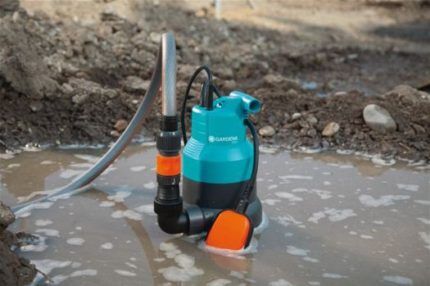
In order to select the device that is optimal in terms of technical parameters, you need to clearly understand what kind of water, dirty or clean, the pumping equipment will have to work with. By pure water we usually mean a liquid that has inclusions no larger than 5 mm in size.
Drainage pumps designed for pumping clean and dirty water differ:
- diameter of the outlet pipe;
- cross-sectional diameter of the suction hole;
- material taken for the manufacture of device parts.
Dirty water can contain solid particles up to 35mm across. Next, it is necessary to determine the total volume of pumped water.
It is also important to find out the depth from which water intake is supposed to be organized, and also take into account the composition of the bottom filter - what size of gravel was used for its construction.
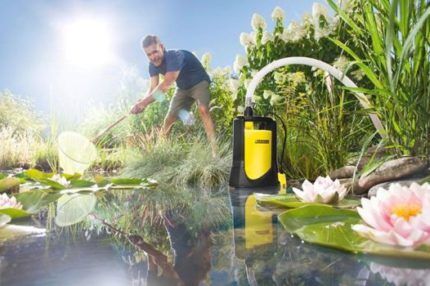
Selecting a pump based on performance and pressure
In addition to water quality, the most important parameters selection of drainage pump include its productivity and pressure. Productivity refers to the volume of water that a pump is capable of pumping in a certain unit of time.
Typically, the performance of pumping equipment is measured in l/h or m3/h, which respectively means liters per hour or cubic meters per hour. This technical parameter shows how quickly the device can clean the well of contaminated water.
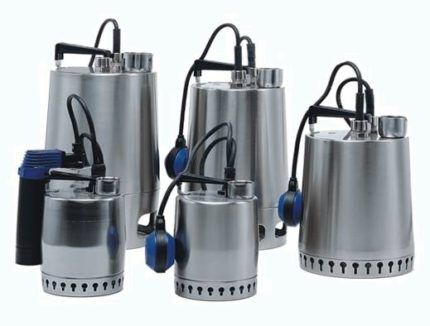
Pressure is an indicator of the height of water rise, measured in atmospheres, bars and meters. This indicator of drainage pumps is usually small, since water is pumped out from a shallow depth. Do not forget about the ratio of vertical and horizontal pressure, which is 1:10.
For example, if you pump water from a well 8 m deep and move it 10 m along a hose lying on the ground to carry it beyond the boundaries of your property, then the pressure at the pump should be at least 9 meters.
It is also necessary to remember that pumps, depending on the lift height, will operate at different levels of performance. Graphs of the dependence of both of these quantities can be found in the instructions supplied with the device.
Types of submersible pumps
To pump out water, owners of suburban land plots use submersible pumps, which can be vibrating or centrifugal. Models differ in the way they absorb water, so the quality of the latter plays an important role when choosing pumping equipment.
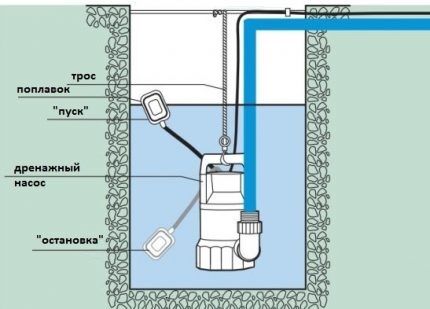
Submersible pumps with centrifugal mechanism
Models that use a wheel with blades as a suction device are called centrifugal. This design feature increases the pump’s performance and also prevents abrasive particles found in the pumped well water from entering it.
Depending on the model, water chambers and centrifugal wheels can be manufactured:
- of steel;
- made from high quality polymer.
Also, a distinctive feature of submersible drainers is the presence in their design of a float or electronic switch. Devices with a float switch are more widespread because they are simpler, cheaper, and most importantly, more reliable. The switch is needed to automate the process of pumping water.

A float is a small sealed container with a contact block inside.When the water level drops float mechanism gradually drops until it reaches acceptable limits. At the maximum depth, it turns off the engine, preventing it from running dry. Dry operation leads to failure of the pumping device.
The drainage pump housing should always be immersed in liquid, as water helps cool the operating mechanism. Water also acts as a lubricant for rotating parts.
Installing a drainage pump: step-by-step instructions
Before starting work to install the pump, determine or arrange a level area so that it operates in a strictly vertical position, then:
- A hose is connected to the pressure pipe using connecting elements for fastening.
- If the model has a float switch, install a check valve on the pressure line.
- A device equipped with a three-phase electric motor must be checked for correct rotation of the centrifugal wheel.
- Turn on the equipment and immediately turn it off, paying attention to the direction of rotation of the pump shaft: clockwise - everything is connected correctly, if not, swap the phases.
- The pump is connected using a carabiner to the electric winch cable or to a rope, making sure that the pressure pipe remains directed upward.
- The unit is slowly lowered to the bottom of the silted well.
- When operating pumping equipment, comply with safety requirements.
If there are signs of equipment malfunction, you must immediately turn off the power supply and stop pumping.
Vibrating Submersible Pumps
Vibration-type pumping equipment operates by changing the internal pressure, causing oscillations of the diaphragm.The difference in pressure appears as a result of the magnetic field generated when an electric current passes through the coil.
Parts set in alternating motion under the influence of a magnetic field raise the water flow upward. Vibration pumps are powered by a 220V power supply and consume approximately 270 W per hour (the figure depends on the power of the model).
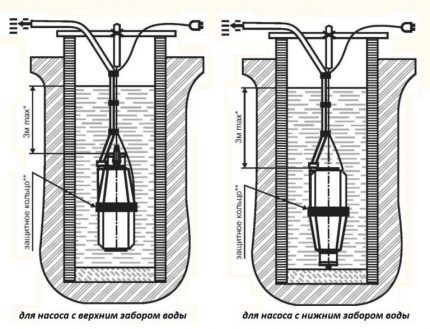
Submersible vibration pumps can be produced with upper or lower water intake from the well:
- Devices with upper water intake operate without overloads, since they do not heat up during operation due to the cooling of the entire system. Also, such pumps do not suck in silt that has settled at the bottom of the well and do not contribute to cloudiness of the water during intake. Therefore, it is not advisable to use them to clean a well.
- Devices with bottom water suction, not equipped with automation and a thermal protection system, since the devices can overheat even during short-term dry operation. To protect mechanisms from sand and silt suction, a mechanical filter is used. Craftsmen replace the filter with an ordinary iron bucket in which the pump is placed. Lower the bucket with the apparatus into a low-flow well and pump water.
Vibration pumps are durable in operation, since their design does not contain rotating elements or bearings, and therefore the parts do not fail without being subject to friction.
When cleaning wells, vibration-type pumping equipment can only be used to pump out turbid water, and sand and silt deposits can be scooped out manually using buckets, homemade scoops, buckets, grabs and other devices.
Selecting a hose for pumping water
Hoses or tubes for pumps must be selected depending on the pressure force, as well as the cross-sectional diameter of the outlet pipe. The main requirement is that the diameter of the hose must match the diameter of the outlet pipe.
Compliance with this requirement will greatly extend the service life of the purchased pump and will have a beneficial effect on its performance.
A fire hose can be used as a flexible hose, which is attached to the outlet pipe using a clamp. At the edge of the well ring, the sleeve is pinched and the pump cannot push through the pumped out water. This problem can be eliminated using a plastic corner, to which fire hoses are connected on both sides.
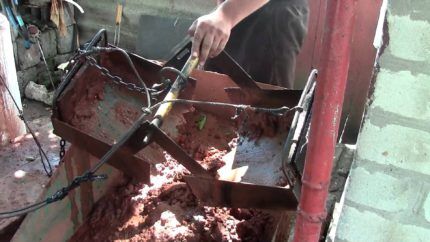
Features of connecting submersible pumps
Before lowering the pump into the well, a number of preparatory measures are carried out, namely:
- determine the depth of the apparatus in the source;
- secure the hose to the pipe using a plastic clamp;
- thread a nylon cord or a small-diameter steel cable into special eyes located on the pump body;
- a special rubber ring is pulled onto the body, which will protect the vibration pump from mechanical damage if it touches the concrete walls of the well shaft;
- Elastic rubber 0.5 meters long is tied to the upper end of the cord so that it dampens vibrations.
The pump with the lower water intake is placed at a distance of 1.0 m from the bottom of the well, and with the upper one slightly lower - 0.5 m. The cable to which the pump is attached is secured to the crossbar installed on the upper well ring. After completing the installation of the equipment, connect the pump to electricity.
If the cord is not long enough, it is extended with an additional cable, and the connection must be located outside the well shaft. While pumping out water, monitor its pressure, preventing the motor from running dry. After two hours of continuous operation, turn off the pump for 15 minutes to avoid overheating of the electric motor.
Cleaning a heavily silted well
If the well is heavily silted, the efficiency of using the drainage pump is sharply reduced. The equipment quickly becomes clogged with sand, and therefore cannot cope with the tasks assigned to it.
In this case, some summer residents advise using another surface pump, which under pressure discharges sand-free water back into the well shaft, thereby facilitating the erosion of bottom sediments.
The method is as follows:
- a barrel or other container is installed near the well, the volume of which is 200-300 liters;
- a drainage pump is lowered into the well shaft, which pumps muddy water from the well into a prepared container;
- the clean water that has settled in the barrel is directed by the second pump back to the well, and the sand from the bottom of the tank is removed;
- a stream of water released under pressure erodes the bottom sand, which, together with the water, is lifted up into the barrel by a drainage pump, and everything is repeated all over again.
This method of cleaning a well has opponents who consider it economically unfeasible. In their opinion, it is more profitable to hire a team of workers who can go down and scoop out the silt with buckets, raising it to the surface. If this is not possible, why not try the option with two pumps.
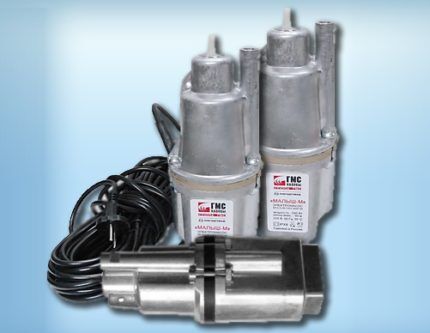
With the help of pumping equipment, a silted well can be easily and quickly cleaned. After pumping out the muddy water, the well is filled with crystal clear life-giving moisture and begins to delight its owners with delicious, cold water.
After cleaning, the pump can always be used for other tasks. Inexpensive vibration models are used in well cleaning after drilling. During floods and rising groundwater, flooded basements are quickly cleared of gushing water.
An inexpensive vibration pump, for example "Spring", you can pump out the pond, clearing its bottom of silt accumulations. A prudent owner will always find a way to increase the efficiency of the purchased equipment.
Rules for operating the pump when cleaning a well
When choosing the necessary model for cleaning a well, carefully read the instructions. After all, some drainage pumps are initially designed to lift and pump only clean water that does not contain impurities. The manufacturer warns about this in the description of the technical characteristics of the equipment.
If such devices begin to pump out contaminated water, they will quickly fail. Remember that cleaning a silted well must be done with a drainage pump that can handle the intake of contaminated liquid that contains impurities and even small fibers.
If persistent deposits appear on the walls and bottom of the well shaft, before using the pump, you must clean the well manuallyto quickly get rid of contaminants and prevent clogging of the working parts of the pump.
Review of popular models
Models from Russian and foreign manufacturers are represented on the pumping equipment market. Every brand has its fans.
Budget pumps from Russian companies “Vikhr” and “Baby» attracts with its affordable price and good performance.German pumps of the brands Wilo Drain, Grundfos, Karcher, like Japanese Makita, do not need advertising.
These devices have high performance and reliability throughout their entire service life. When purchasing pumping equipment, be sure to check the availability of all components specified in the attached instructions.
Pay attention to the restrictions on use specified by the manufacturer. Remember that the technical characteristics of different pump models may differ significantly, which also affects the way they are used.
Conclusions and useful video on the topic
The video provides recommendations for pumping water from a well with a submersible drainage pump and then removing sand with a homemade scoop.
Practical advice: when cleaning wells, a float is tied to a rope or cable on which the pump is attached in order to pump out water from the maximum possible depth. In this case, of course, the manufacturer’s recommendations for operating the equipment are violated, but it is possible to free the well from water almost to the very bottom.
At the end of this video, you will see how to use two top and bottom submersible pumps to clean a well.
After watching this video, you will learn how to clean a well with a vibration pump, usually used only to lift clean water.
Drainage pumps are indispensable assistants in the garden and countryside. These inexpensive devices are characterized by ease of operation, ease of installation and the effectiveness of the results of their use.
Would you like to talk about how you cleaned a well in a suburban area with a pump? Did you have any questions while reading the article? Please write in the block below.




The husband's parents left the house to their grandchildren. The house and country plot with a well have not been used for more than 10 years. And the well was not cleaned even longer. Now children come there as if they were going to a dacha, but the problem is the well. It is almost half filled with sand. There is no silt. My son-in-law is young and has never done this. I can only help with memories of when my husband pumped out water and handed buckets of sand to his assistant on a rope from the well. I have a question from an amateur: what pump do you recommend at a budget price for wells in which the water contains a certain amount of sand? We’ll definitely use the recommendations, even I’m interested.
We recently purchased a farm in the Vladimir region. The area of the land plot is 2.4 hectares. There is room to turn around. However, the land was empty for a long time. The irrigation system used by the old owners had become dilapidated, and a lot of silt deposits had accumulated in the wells, resulting in an unpleasant odor. Need help: what to do in such a situation? Should we reconstruct the old water supply system, or should we make a new one? Will pumping equipment help in this case?
Hello Mikhail. As for the silt deposits in the well, if this is the problem, then you can easily get rid of them and continue to use this water.
To remove sludge from the bottom of the well, I recommend using a grab. You can borrow it from someone or make it yourself. I recommend the second option, such a device will be useful on the farm. I attach a photo and a detailed diagram.
Regarding the old irrigation system, in this case it all depends on the degree of blockage and damage. Dry cleaning cannot be used here.Tapping and cleaning with a cable is also not an option. All that's left is hydro-jet cleaning. Here you will have to calculate what will cost less: such cleaning or replacement of the irrigation system.
Hello! Please tell me how you can clean the well from silt and debris. The inner diameter of the pipe is 24.5 cm.